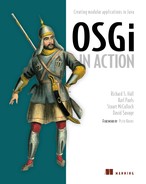Preface
When I started working with OSGi technology back in 2000, I would’ve never guessed I’d still be working with it a decade later. Back then, OSGi was targeting the embedded market niche, but that wasn’t my area of interest. I wanted to create highly dynamic, modular applications, and OSGi gave me the possibility of doing so. At the time, there weren’t any freely available OSGi framework implementations; so I started working on my own open source implementation, called Oscar, back in December 2000 while I was working at Free University Berlin. Oscar moved with me when I moved to Grenoble to work at Josef Fourier University, where the work really started to flourish.
As OSGi technology began to gain traction, Oscar moved to the ObjectWeb open source consortium in 2004, and later it evolved into Felix at the Apache Software Foundation in 2005. I was fortunate enough to be invited by the OSGi Alliance to work directly on the OSGi specifications for the R4 release cycle in 2004. I’ve been involved in the OSGi specification process ever since, initially as an academic researcher and most recently in industry, when I took a position on the GlassFish team at Sun Microsystems (now Oracle Corp.) in 2008. A lot has changed over the last 10 years.
OSGi technology has moved beyond the embedded market into a full-blown module system for Java. This transformation was significantly helped along in 2004 when the Eclipse IDE refactored its plugin system to run on top of OSGi, and it has continued with the adoption of the technology in enterprise circles by Spring and all the major application servers. Although the future of Java modularity is still evolving, OSGi technology looks to play a role for a long time to come. Which brings us back to this book.
I’d been kicking around the idea of writing an OSGi book for a couple of years, but given the enormity of the task and my life-long time deficit, I never got around to it. In the summer of 2008, I finally got serious and began writing, only to find myself quickly bogged down. It wasn’t until Karl and Stuart offered to help, and later David, that we were finally able to slay the beast. Our varied OSGi experience provided just the right mix. Even then, it’s taken us two years, a few career changes, and the birth of several children to see it to an end. We hope you’ll find our efforts helpful.
RICHARD S. HALL
